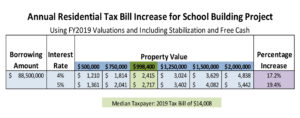I have been delighted over the last couple of years as Lincoln has reached a tipping point on clean energy. We are working toward the elimination of CO2 emissions for our town buildings. We are working on Community Choice Aggregation to increase the renewably generated supply of our electricity throughout the town. There are a rapidly growing number of electric vehicles (EVs) in town and many of us have already made the switch to renewably generated electricity directly and/or indirectly.
The Lincoln School building project represents more than 50 percent of our energy consumption in our town buildings. It is a critical piece of the puzzle to move Lincoln forward on our clean energy journey. We also need models like Lincoln at a town, school, and church level to act as building blocks that can be replicated in nearby towns and across Massachusetts.
The key aspects of our net-zero school are establishing a high-efficiency building envelope, converting all of our systems to electricity, and providing all of the energy (electricity) required to operate our school from on-site solar-generated electricity. In addition, there are embodied energy savings due to the fact that we are saving portions of the existing school infrastructure. That is to say, the portions of the building that will not be newly constructed will not require CO2 emissions to produce those materials, transport them, and build with them.
The educational aspects of a net-zero school include the engagement of students, faculty, and others in the community around electricity use and the study of the operational data collected. This results in a more sustainable environment as we understand how our use of the school impacts electricity demand, which enables us to modify our behavior and electricity consumption.
Financially, a Power Purchase Agreement (PPA) for solar arrays on the school rooftops and adjacent carports is an ideal way for the town to eliminate upfront capital costs, reduce current operating costs, and eliminate the unpredictability of fossil fuel prices in the future.
Please vote YES on December 1 and 3 at Town Meeting and in the ballot booth.
Sincerely,
Peter Watkinson
9 Wheeler Rd. #81, Lincoln
Letters to the editor must be signed with the writer’s name and street address and sent via email to lincolnsquirrelnews@gmail.com. Letters will be edited for punctuation, spelling, style, etc., and will be published at the discretion of the editor. Letters containing personal attacks, errors of fact or other inappropriate material will not be published.


